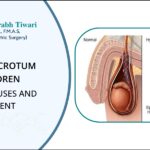Introduction
Gastroesophageal Reflux Disease (GERD) is a common and often misunderstood condition in children. Dr. Saurabh Tiwari, a distinguished pediatric surgeon, sheds light on this prevalent issue affecting the digestive health of young ones. In this comprehensive blog, we’ll explore the causes, symptoms, diagnosis, and treatment options for GERD in children.
Understanding GERD in Children
GERD is a chronic digestive disorder where stomach contents flow back into the esophagus, causing discomfort and potential damage over time. While adults may experience heartburn, children often exhibit different symptoms, making it crucial for parents and healthcare providers to be vigilant.
Causes
Dr. Tiwari emphasizes that GERD in children can result from a variety of factors. One major contributor is the immaturity of the lower esophageal sphincter (LES), a muscle that separates the esophagus from the stomach. In some cases, an abnormality in this muscle can lead to persistent reflux.
Other factors include obesity, hiatal hernia, certain medications, and neurological disorders that affect the functioning of the digestive system. Identifying the root cause is essential for effective management.
Symptoms
Recognizing the signs of GERD in children is vital for early intervention. Common symptoms include:
- Recurrent Vomiting: Frequent episodes of regurgitation or vomiting, especially after meals.
- Poor Weight Gain: Reflux can affect a child’s appetite, leading to inadequate weight gain or even weight loss.
- Respiratory Issues: Chronic cough, wheezing, and recurrent respiratory infections may indicate GERD-related issues.
- Abdominal Pain: Children may experience abdominal discomfort, often mistaken for other gastrointestinal problems.
Diagnosis
Accurate diagnosis is critical for devising an effective treatment plan. Dr. Tiwari underscores the importance of a thorough medical history and physical examination. In some cases, additional diagnostic tests may be required, such as:
- Upper Endoscopy: A flexible tube with a camera is inserted into the esophagus to visualize any abnormalities.
- PH Monitoring: This test measures the acidity level in the esophagus, providing valuable information about the frequency and duration of reflux episodes.
- Barium Swallow: A contrast material is used during X-rays to highlight the esophagus, helping identify structural abnormalities.
Treatment Options
Once diagnosed, Dr. Tiwari outlines various treatment approaches tailored to the severity and underlying cause of GERD in children:
- Lifestyle Modifications: Dietary changes, such as avoiding acidic and spicy foods, smaller and more frequent meals, and maintaining an upright position after meals.
- Medications: Antacids, acid blockers, and proton pump inhibitors (PPIs) may be prescribed to reduce stomach acid and alleviate symptoms.
- Surgical Intervention: In severe cases or when conservative measures fail, surgery may be considered to strengthen the LES or correct structural abnormalities.
Conclusion
Dr. Saurabh Tiwari’s expertise in pediatric surgery brings a wealth of knowledge to the understanding and management of Gastroesophageal Reflux Disease in children. By fostering awareness, recognizing symptoms early, and implementing appropriate interventions, parents and healthcare providers can collaborate to ensure the optimal digestive health of the younger generation. It is through such comprehensive insights and a multidisciplinary approach that we can strive towards better outcomes for children affected by GERD.




